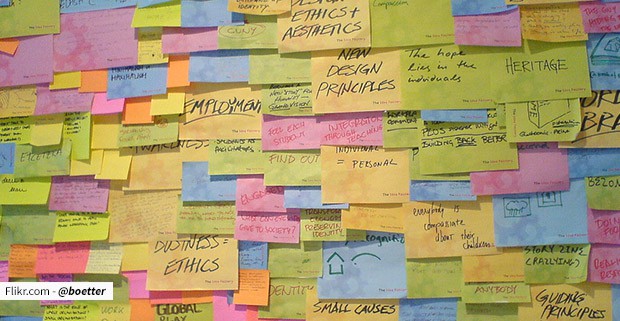Group brainstorming sessions can be great spaces of collaboration where innovative products and cost-cutting services are born from that one, wild idea. Free-flowing idea generation can turn the most rigid of boardrooms into a space where, for a moment, the dress shoes become unlaced and tossed aside.
In 7 Tips on Better Brainstorming, the team behind OpenIDEO shares their advice for effective brainstorming in traditional group settings. Here are few ways to get your ideas flowing in no time.
1. Don’t Limit Your Ideas
Brainstorming is best when we can think freely and come up with wild ideas. It allows us to think about what we really want if we didn’t have to worry about things like technology restrictions or costs. Encourage the wild ideas, as any road bumps you encounter are just opportunities to build new technologies or software that can help deliver them.
Brainstorming for an hour and walking away with only 2 or 3 ideas may be a sign that too much time is being spent on dissecting, debating, and over-analyzing ideas during the brainstorming process.
2. Build. Build More.
Ideas beget ideas. By encouraging an environment free from judgment, it allows everyone to speak their mind and let the ideas flow in an uninhibited manner.
You can foster a judgment free zone by mastering the skill of the skill of saying “and” instead of “but” when building upon someone else’s idea. The word “but” is normally used to introduce an objection, whereas “and” shows that you have an open mind to an idea. It allows you to keep building while still being able to pose questions and provocations, and make everyone feel like their ideas are valued.
3. Quantity Counts
Generate as many ideas as you can. Brainstorming for an hour and walking away with only 2 or 3 ideas may be a sign that too much time is being spent on dissecting, debating, and over-analyzing ideas during the brainstorming process. While that’s certainly important, you should really start refining only once you have a large bank of ideas to choose from, or during a second session dedicated to fleshing out your ideas further.
4. Try Visual Brainstorming
Cover your walls with Post-its. Turn your whiteboard into a work of erasable-marker-art. Drawing, writing, sketching, and more, will make your ideas memorable. Visual brainstorming can also provide clarity to an idea that you may have trouble expressing with words. Plus, it lets you showcase your Picasso-esque drawing skills.
5. Stay Focused on The Topic
Throughout all this, the wild ideas to the post-it notes and everything in between, you need to remember that you’re brainstorming for a specific reason, and need to keep the session(s) on target. Getting off-topic while brainstorming will only stifle the process and add unnecessary noise. If you think of an off-topic idea during the brainstorming session, make a note of it and bring it up later on when the time calls for it.
